| |
|
|
|
|
English Family Quick Links
|
|
|
|

|
|
|
|
|
Family 21: Moonah Barb Mare
 |
VIEW DESCENT CHART
The Moonah Barb mare is so entered in the General Stud Book, with the sub-title "Queen Anne's." Her dam, carrying her in utero,was one of five mares and nine stallions purchased in Barbary by King William III's stud-master at Hampton Court, Richard Marshall, and imported into England in 1699-1700. This was attested to in a pedigree sent to Yorkshire breeder Cuthbert Routh by Marshall. She is one of three mares at the roots of thoroughbred pedigrees that can actually be shown to have been imported from the near east.
|
Family 21 Overview
Moonah Barb Mare (c.1700) by Hampton Court Barb [21]
Mare by Leedes
Mare (1731) by [Godolphin] Whitefoot
Brown Betty (1737) by Hobgoblin
| Sophia (1748) by Godolphin Arabian
| Mare (1757) by Oroonoko
| Mare (176-) by Sampson
| Mare (177-) by Damascus Arabian
| Mare (17--) by Ancaster
| Miss Grimstone (1796) by Weazle
| Mare (1812) by Orville
| Wagtail (1818) by Prime Minister [21-A]
Shireborn (1739) by Hobgoblin
Selima (1745) by Godolphin Arabian [SELIMA]
| |
The Moonah Barb mare would have been around 2 years old when Queen Anne ascended the throne. Sister to William III's queen, Mary, and like her, a daughter of James II, Queen Anne was a sporting enthusiast. Towards the end of her reign, suffering from gout, rather than give up hunting, she followed the hunts in a chaise over paths created for her in Windsor Forest. She was likewise a great supporter of horse racing, directing her Master of the Horse, Charles Seymour, (6th) Duke of Somerset, to provide funds to workmen employed "..in making and perfecting the round heat" at Ascot, where the first race was held in 1711. She gave the Queen's Plate of 100 guineas for this first running, and likewise sponsored races at other meetings, including Clifton and Rawcliffe Ings in 1712 and 1714, and at Datchet, and provided royal plates at Stapleton Leys (1703) Langton Wold (1707), Black Hambleton (1709) and Newmarket.
|
In 1705 Queen Anne presented her consort, Prince George of Denmark, with Leedes, "a running horse" purchased from Mr. Holloway, "which cost a 1,000 guineas." This horse, by the Leedes Arabian and out of a mare by Spanker, later sired the Leedes mare from the Moonah Barb mare, through whom Family 21 descends to the present. The Leedes mare appears to have been owned by Sir John Dutton (2nd) Baronet of Sherborne. The Dutton family had close horse-breeding ties with the Earl of Godolphin, and a number of exchanges and transactions regarding mares and foals took place between them. In addition to producing the good racehorse Tarquin, The Leedes mare produced a filly named Lady Cow, who produced the racehorse and later sire, Marksman, by the Godolphin Arabian. Lady Cow was in the Godolphin stud for around ten years in the 1740s, with some of her produce, including Marksman, sent to the Dutton stud. The most significant of the Leedes Mare's produce from a historical perspective was a filly by (Godolphin or Bolton) Whitefoot.
Sir John Dutton died in 1743, but the horse breeding connection with Godolphin was continued by Sir John's brother-in-law, James Naper, and his son, James, who assumed the last name of Dutton when he inherited his uncle's estate at Sherborne. A number of the Whitefoot Mare's fillies ended up in the Godolphin Stud--the Hobgoblin mare of 1736, dam of Fly, Shepherdess and Noble; Brown Betty, dam of Mirza, Infant and mares that bred on; Miss Dutton; and Shireborn, dam of Saxham, the famous Selima, Chub, and others. It was through these mares and their offspring, largely bred at the Godolphin Stud, that the family continued.
Five foals are attributed to the Moonah Barb mare in the GSB; one, the Cripple Barb, also called Croft's Bay Barb, was a colt, and the rest were fillies, all but possibly the last filly, (Milbanke's) Doll, were bred at the royal stud. The Cripple Barb was sired by King William's White Barb, Chillaby, who was also imported by Marshall. The Cripple Barb was retained at Hampton Court, where he is known to have sired two fillies from a mare by Makeless given to Queen Anne by Yorkshire breeder John Croft. After 1712 he sired several other mares listed in the GSB, important in Families 2 and 4, all of whom are listed as bred by Croft, probably at his stud in Barforth, Yorkshire. In addition to the Cripple Barb and the Leedes Mare, the Moonah Barb mare's most significant offspring was Milbanke's Doll, who was a good racemare and later produced Rib, by (1736, Old Crab). Rib was a good racehorse in his time, and produced some good runners, some of which bred on.
With the discovery of the Earl of Godolphin's studbook in the early part of the 20th century, it was determined that the General Stud Book had erroneously attributed the famous American broodmare, Selima, to Family 15, as a daughter of The Large Hartley Mare (Sachrissa), an error also perpetuated in the American Stud Book. The Godolphin stud book showed her to be a daughter of Shireborn, the mare by Hobgoblin and out of the (Godolphin) Whitefoot mare, in the Earl's stud. Consequently, Selima, who was to become so important in American bloodlines, belongs to Family 21, rather than Family 15, and the pop-up reference chart and material on this page is adjusted to reflect that. For more information on Selima, see this article, published in the Thoroughbred Times.
|
|
|
FAMILY #21 NOTABLE DESCENDANTS
|
|
Family #21 Oaks Winners
|
 |
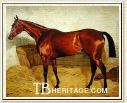 |
| Iris |
Lonely |
|
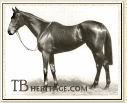 |
|
|
Neasham Belle
|
|
1790 HIPPOLYTA ch.f. 1787 [21]
(Mercury - Hip) |
1851 IRIS ch.f. 1848 [21]
(Ithuriel - Miss Bowe) |
1885 LONELY b.f. 1882 [21-A]
(Hermit - Anonyma) |
1951 NEASHAM BELLE b.f. 1948 [21-A]
(Nearco - Phase) |
2006 ALEXANDROVA b.f. 2003 [21-A]
(Sadler's Wells - Shouk) |
|
|
|
|
Family #21 St. Leger Winners
|
|
|
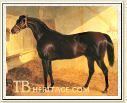 |
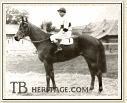 |
| Charles The Twelfth |
Heathersett |
|
1839 CHARLES THE TWELFTH br.c. 1836 [21-A]
(Voltaire - Wagtail) |
1962 HETHERSETT b.c. 1959 [21-A]
(Hugh Lupus - Bride Elect) |
1973 PELEID b.c. 1970 [21-A]
(Derring-Do - Winning Bid) |
|
|
Family #21 Other Family Members
|
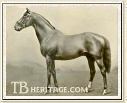 |
| Bachelor's Button
|
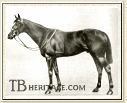 |
| Bachelor's Double
|
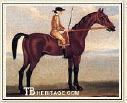 |
| Bajazet
|
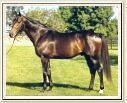 |
Broad Brush
Image Courtesy Tony Leonard
|
 |
| Cinderella
|
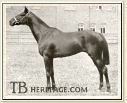 |
| Dinneford
|
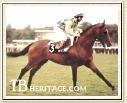 |
| Exceller
|
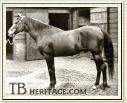 |
| Foxhall
|
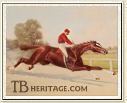 |
| Hanover
|
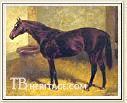 |
| Hastings
|
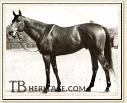 |
| In Reality
|
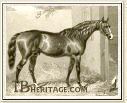 |
| Longbow
|
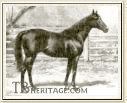 |
| Maltster
|
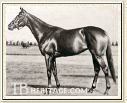 |
| My Dear Girl
|
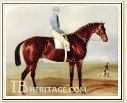 |
| Physician
|
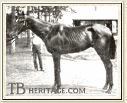 |
| Plaudit
|
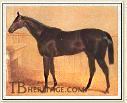 |
| Sweetmeat
|
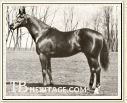 |
| Victorian
|
|
Bachelor's Button ch. c. 1899 [21-A]
(Winkfield- Milady)
Long-running top stayer won sixteen of over forty races, including the Ascot Gold Cup, the Ascot Gold Vase, twice, the Doncaster Cup, and the Hardwicke Stakes. His dam, who won a small race on the flat and also went over hurdles, also produced Lady Bawn, dam of Bachelor's Double, see below. |
Bachelor's Double ch. c. 1906 [21-A]
(Tredennis - Lady Bawn)
Unbeaten two year old, his wins included the Phoenix Park Nursery Plate and the Railway Stakes at the Curragh. Between ages 3 and 5 he won, among other races, the Irish Derby, the City and Suburban Handicap, the Ascot Royal Hunt Cup, and the Great Jubilee Handicap at Kempton Park, placing second in the Doncaster Cup and Coronation Cup. Best known as sire of Double Life, the dam of Precipitation and Persian Gulf, he also got Bella Minna, a decent race mare and stakes winner and dam of Italian classic winner Bellini, Oaks winner Love in Idleness, and Grand Prix de Paris winner Comrade. |
Bajazet b.c. 1740 [21]
(Godolphin Arabian - Mare by Whitefoot)
Good English racehorse and sire of the mid-eighteenth century; several daughters seen tail-female in various families. |
Broad Brush b. c. 1983 [21-A]
(Ack Ack - Hay Patcher)
Athletic, durable horse won or placed in 22 stakes out of 27 starts, including the Suburban Handicap, the Santa Anita Handicap, and the Wood Memorial Invitational. The most prominent contemporary representative of the once dominant Domino sire line, he was leading sire in the U.S. in 1994. Offspring include Best of Luck; Schossberg; Concern; Broad Dynamite, and a number of other stakes winners. |
Cinderella b. f. 1885 [21-A]
(Tomahawk or Blue Ruin - Manna)
An important influential matron in the U.S., she was born in England and brought to U.S. as a yearling. Bad-tempered and unraced, she bred six stakes winners; the most notable were sons Plaudit (see below) and Hastings (see below), both good winners and important stallions. Daughter Slippers, dam of Preakness Stakes winner Buskin, continued the tail-female line; Heavenly Cause (1978), top three-year-old filly in the U.S., is a recent representative. |
Dinneford br. c. 1902 [21
(Dinna Forget - Gracie)
Good winner of the July Cup, Princess of Wales' Stakes and Royal Hunt Cup. His offspring included Dinner (dam of City and Suburban Handicap winner Dry Toast and of Criterion Stakes winner Treat) and Prescription, an ancestress of Prince Bio and of Grand Criterium winner and French sire Teleferique. |
Exceller b. c. 1973 [21-A]
(Vaguely Noble - Too Bald)
Handsome colt ran in France for two years, winning the Grand Prix de Paris and Prix Royal Oak, among others, and from ages four to six in the U.S., winning the Canadian International Championship Stakes, the Santa Anita Handicap and the San Juan Capistrano Handicap, among other top races. The only horse to beat two Triple Crown winners, Seattle Slew and Affirmed, in the Jockey Club Gold Cup, in 1978. In sixteen crops, sired 19 stakes winners, including the top race fillies Squan Song, and Slew's Exceller. Sold to Sweden in 1991, he was sent to slaughter, although neither injured nor ill; the Exceller Fund, established in his memory, raises money to rescue thoroughbreds in the U.S., who would otherwise face a similar fate. His dam, Too Bald, was Broodmare of the Year in the U.S. |
Foxhall b. c. 1878 [SELIMA]
(King Alfonso - Jamaica)
Top racehorse of the early 1880s, he could win at 9 furlongs and at twice the distance. Bred in the U.S. and shipped to Europe to run, he was not entered in the classics. One of a trio of American "invaders" that also included Robert the Devil and Iroquois, he won five of his seven races there at age 3, including the Cesarewitch Stakes and the Cambridgeshire Stakes, in the latter conceding 32 lbs. to the place-runner; the Grand Prix de Paris at Longchamp, and the Grand Duke Michael and Selects Stakes at Newmarket. At age 4 he won the Ascot Gold Cup. Not a success at stud, his distant female descendants produced some good runners. |
Grakle b. g. 1922 [21]
(Jackdaw - Lady Crank)
Irish-bred winner of the Grand National at Aintree in 1931. |
Hanover ch. c. 1884 [SELIMA]
(Hindoo - Bourbon Belle)
Big, flashy chestnut colt, won his three races at age 2, although had to be ridden hard to do it. At age 3 his speed matched his looks, flashy and powerful, winning 20 of his 27 starts, with seldom any rest, and usually under top weight and against the best in the country. His wins included the Belmont Stakes by 15 lengths, the Withers Stakes, the United States Hotel Stakes and many others. Leading the U.S. sire lists five times in the 1890s, his best including Hamburg, Halma, Yankee, The Commoner, and many more, and he is present in the pedigrees of more recent horses such as Epsom Derby winners Orby, Durbar II, and Grand Parade. Euthanized in 1899, when he repeatedly damaged his nerved forefoot by striking his stall wall in impatience for food; the cartilage in his foot began to disintigrate and gangrene set in. |
Hastings br. c. 1893 [21-A]
(Spendthrift - Cinderella)
Won ten of his 21 races, ages 2 to 4, and was second eight times; although he won the Belmont Stakes, he was best at distances under a mile. He was a good weight carrier, and ran in top company. In the stud, he proved to have a vicious temper, and was a serious management problem. He led the U.S. sire list twice, with a tendency to throw precocious two year olds; his best the significant, and likewise temperamental, stallion Fair Play, sire of Man o' War. Also sired top handicap mare Gunfire; Don Enrique (Preakness Stakes); Flamma (Kentucky Oaks); Masterman (Belmont Stakes). His dam, Cinderella, to whom his temper is generally attributed, also produced Kentucky Derby winner Plaudit (see below) and Slippers (second dam of top three year old filly Prudery, who was dam of Victorian, Whiskery and Halcyon). |
Hethersett b. c. 1959 [21-A]
(Hugh Lupus - Bride Elect)
Won two races at age 2. At age 3, was favored for the Derby, but fell with other runners when Romulus went down; he went on to win the St. Leger and the Great Voltigeur Stakes. Ran unsuccessfully at age 4, and was retired to stud; he died early, at age 7, but still got Blakeney (Epsom Derby, sire of Oaks winner Juliette Marny, St. Leger winner Julio Mariner, and others), Rarity (Desmond Stakes, Ballymoss Stakes, sire of 1,000 Guineas winner One in a Million), Highest Hopes (Prix Vermeille), Hibernian (Beresford Stakes and Irish Cambridgeshire). His dam won the Queen Mary Stakes and was half-sister to dual Manchester Cup winner Chatsworth and to Pirate King, winner of Newmarket's Craven Stakes and the St. James's Palace Stakes, among other races. |
In Reality b. c. 1964 [21-A]
(Intentionally - My Dear Girl)
Won fourteen of his twenty-seven races, ages 2 to 4, including the Jersey Derby, the Florida Derby, and the Hibiscus Stakes, running in top company. Leading sire of two year olds in the U.S. once, and in the top ten of U.S. leading sires four times, he got 81 stakes winners, the best among them including Believe It, who won the Wood Memorial Stakes and sired the good handicapper Al Mamoon; two good sires, Valid Appeal and Relaunch; U.S. champion three year old filly Desert Vixen; champion miler in England, Known Fact, and a number of others. |
Lonely b. f. 1882 [21-A]
(Hermit - Anonyma)
Good race filly, won six races at age 2, including the Rous Stakes and the Hopeful Stakes, and went on at age 3 to win the Epsom Oaks Stakes and place third in the St. Leger. Dam of Ice Maiden (Yorkshire Oaks, Ascot Gold Vase), Barley (dam of Maltster, see below), Arena (ancestress of My Dear Girl, In Reality, Tank's Prospect, etc.), Musidora, and a number of other fillies that bred on. |
Longbow b. c. 1849 [21]
(Ithuriel - Miss Bowe)
Top race horse at a mile and over, and a good weight carrier, he ran from ages 2 to 4. His best wins included the Eglinton Stakes at York, the Gratwicke Stakes at Goodwood, the Doncaster Stakes and the Royal Stakes, all at age 3, and the Union Cup handicap at Manchester and the Stewards' Cup at Goodwood at age 4. In a hard-fought battle placed second to Stockwell in the Great Yorkshire Stakes in 1852. Sired Oaks winner Feu de Joie; Thousand Guineas winner Sagitta; several good producers, including Mrs. Quickly (dam of Doll Tearsheet); and the influential stallion Toxophilite (sire of Musket, Stray Shot, Mosquito, Quiver). Full brother to Oaks winner Iris (see above, with her cat), who also placed second in the Yorkshire Oaks. Their dam, Miss Bowe, was a prolific and highly successful producer who, "when in her thirtieth year, was as fresh and shapely as any mare of half her age." |
Maltster b. c. 1897 [21-A]
(Bill of Portland - Barley)
Won the AJC Derby and the Victoria Derby, and ran second in the Melbourne Cup. Champion sire in Australia five times, whose progeny won £290,358, a large amount for the first decade of the 20th century. Among his top offspring were Malt King (All-Aged Stakes, twice; Rawson Stakes, twice); Miss Bass (VATC Debutante Stakes, second dam of VRC Victoria Derby and AJC Sydney Cup winner Johnnie Jason); Dovelet (dam of sisters Mother Superior (Welcome Stakes and others), and Eaglet (CJC New Zealand Oaks and Waikato Cup)); Alawa (VRC Derby Stakes, Melbourne Stakes and others). Members of Barley's family are still winning stakes in Australasia. |
My Dear Girl ch. f. 1957 [21-A]
(Rougn'n Tumble - Iltis)
Champion 2 year old filly in the U.S., winner of the Frizette Stakes and the Gardenia Stakes, in all eight wins in twenty starts. A good producer, dam of In Reality (see above), Superbity (Flamingo Stakes, Marylander Handicap and others, sire), Gentle Touch (second dam of Dr. Carter), and Return to Reality (Sussex Turf Handicap and others). |
Neji b. g. 1922 [21-A]
(Hunter's Moon IV - Accra)
Descended in tail-female from Cinderella (above), a big chestnut gelding owned by Mrs. Ogden Phipps. He was one of the all-time great steeplechasers, completely dominating American chasing over six year, almost always carrying top weight, with an exciting come-from-behind style. He won 17 of 37 races, only once out of the money; he was a three time winner of the American Grand National, and three-time Champion U.S. Steeplechaser. |
Physician b. c. 1829 [21]
(Brutandorf - Primette)
Won fourteen races, ages 3 to 5, including The Stanley Stakes, the Manchester Gold Cup, the Liverpool Croxteth Stakes and the Doncaster Scarborough Stakes, beating Birdcatcher in the latter two races. In the stud, he got the good racehorse The Cure, who had a sigificant impact on thoroughbred breeding through his daughters, especially the race filly Little Agnes, an important mare in Family 16, and dam of Tibthorpe and a number of daughters who bred on; and Polly Agnes, dam of the good racemare Lily Agnes (dam of Triple Crown winner Ormonde). Also sired Underhand (Great Ebor Handicap, Manchester Cup, and sire) and other good horses. |
Plaudit br. c. 1895 [21-A]
(Himyar - Cinderella)
Half-brother to Hastings, he won the Nursery, Champagne Stakes and Kentucky Derby. In the stud he got King James (Metropolitan and Brooklyn Handicaps and others), who was sire of My Own, Spur (sire of Sting and grandsire of top U.S. race horse Questionnaire), and King Nadi, all good stakes winners. Plaudit also sired Rosa Mundi, dam of the top three year old race filly Rose of Sharon, and Casuarina, tail-female ancestress of the good race mare Miss Dolphin (dam of Olympia). |
Sweetmeat br. c. 1842 [21-A]
(Gladiator - Lollipop)
Lightly-made, with a refined head and neck, and a heavy shoulder. Won the Stanley Stakes and two other races as a juvenile; at age 3 won the Doncaster Cup, the Ascot Queen's Vase, and seven other good races. At ages 4 and 5 he ran a few races, but did not place, and was retired to the stud after he injured his foreleg; later he went blind. His offspring were fast, but tended to do best at shorter distances, among them the good race fillies Marchioness, Nettle, Citron, and Comfit. Daughter Mincemeat won the Oaks Stakes, and was dam of the racehorse and sire Tomahawk. Sweetmeat's sons included Parmesan (Ascot Gold Vase) and Macaroni (2,000 Guineas, Epsom Derby and Doncaster Gold Cup, top broodmare sire of such dams as Lily Agnes (Ormonde), Mavis (dam of Galliard), Vista, Frivolity, and Concertina (dam of Plucky Liege)) , both of whom had sire sons that bred on for a few generations. |
Victorian b. c. 1925 [21-A]
(Whisk Broom II - Prudery)
Top 3 year old of his generation, in terms of earnings, he won ten of his races that year, including the Preakness Stakes, the Withers Stakes, and others; at age 5 he won the Agua Caliente Handicap. His best offspring was He Did, winner of the Santa Anita Derby and other races. His brother, Kentucky Derby winner Whiskery, was the top 3 year old of 1927. Their dam, Prudery, a very good race filly who won the Alabama Stakes and other races, also produced Halcyon, who won 17 races in 84 starts, including the Hopeful Stakes and the Queens County Handicap (twice). |
|
| |
|
|
|
|
|

